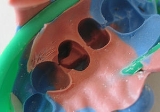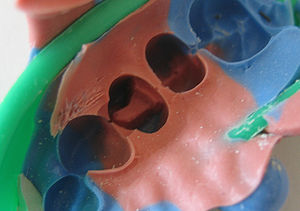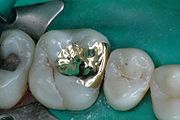
Onlay
Encyclopedia
In dentistry
, an inlay is an indirect restoration (filling) consisting of a solid substance (as gold
or porcelain
) fitted to a cavity in a tooth and cemented into place. An onlay is the same as an inlay, except that it extends to replace a cusp
. Crowns are onlays which completely cover all surfaces of a tooth.
 Sometimes, a tooth is planned to be restored with an intracoronal restoration, but the decay or fracture is so extensive that a direct restoration
Sometimes, a tooth is planned to be restored with an intracoronal restoration, but the decay or fracture is so extensive that a direct restoration
, such as amalgam
or composite
, would compromise the structural integrity of the restored tooth or provide substandard opposition to occlusal (i.e., biting) forces. In such situations, an indirect gold or porcelain inlay restoration may be indicated. When an inlay is used, the tooth-to-restoration margin may be finished and polished to such a super-fine line of contact that recurrent decay will be all but impossible. While these restorations might be ten times the price of direct restorations, the superiority of an inlay in terms of resistance to occlusal forces, protection against recurrent decay, precision of fabrication, marginal integrity, proper contouring for gingival (tissue) health, and ease of cleansing offers an excellent alternative to the direct restoration.

or composite restorations inadequate, such as cuspal fracture or remaining tooth structure that undermines perimeter walls of a tooth, an onlay might be indicated. Similar to an inlay, an onlay is an indirect restoration which incorporates a cusp or cusps by covering or onlaying the missing cusps. All of the benefits of an inlay are present in the onlay restoration. The onlay allows for conservation of tooth structure when the only alternative is to totally eliminate cusps and perimeter walls for restoration with a crown
. Just as inlays, onlays are fabricated outside of the mouth and are typically made out of gold or porcelain. Gold restorations have been around for many years and have an excellent track record. In recent years, newer types of porcelains have been developed that seem to rival the longevity of gold. If the onlay or inlay is made in a dental laboratory, a temporary is fabricated while the restoration is custom-made for the patient. A return visit is then required to fit the final prosthesis. Inlays and onlays may also be fabricated out of porcelain and delivered the same day utilizing techniques and technologies relating to CAD/CAM dentistry
.
Dentistry
Dentistry is the branch of medicine that is involved in the study, diagnosis, prevention, and treatment of diseases, disorders and conditions of the oral cavity, maxillofacial area and the adjacent and associated structures and their impact on the human body. Dentistry is widely considered...
, an inlay is an indirect restoration (filling) consisting of a solid substance (as gold
Gold
Gold is a chemical element with the symbol Au and an atomic number of 79. Gold is a dense, soft, shiny, malleable and ductile metal. Pure gold has a bright yellow color and luster traditionally considered attractive, which it maintains without oxidizing in air or water. Chemically, gold is a...
or porcelain
Porcelain
Porcelain is a ceramic material made by heating raw materials, generally including clay in the form of kaolin, in a kiln to temperatures between and...
) fitted to a cavity in a tooth and cemented into place. An onlay is the same as an inlay, except that it extends to replace a cusp
Cusp (dentistry)
A cusp is an occlusal or incisal eminence on a tooth.Canine teeth, otherwise known as cuspids, each possess a single cusp, while premolars, otherwise known as bicuspids, possess two each. Molars normally possess either four or five cusps...
. Crowns are onlays which completely cover all surfaces of a tooth.
Inlays

Dental restoration
A dental restoration or dental filling is a dental restorative material used to restore the function, integrity and morphology of missing tooth structure. The structural loss typically results from caries or external trauma. It is also lost intentionally during tooth preparation to improve the...
, such as amalgam
Amalgam (dentistry)
Amalgam is an alloy containing mercury. The term is commonly used for the amalgam employed as material for dental fillings, which consists of mercury , silver , tin , copper , and other trace metals...
or composite
Dental composite
Dental composite resins are types of synthetic resins which are used in dentistry as restorative material or adhesives. Synthetic resins evolved as restorative materials since they were insoluble, aesthetic, insensitive to dehydration, easy to manipulate and reasonably inexpensive...
, would compromise the structural integrity of the restored tooth or provide substandard opposition to occlusal (i.e., biting) forces. In such situations, an indirect gold or porcelain inlay restoration may be indicated. When an inlay is used, the tooth-to-restoration margin may be finished and polished to such a super-fine line of contact that recurrent decay will be all but impossible. While these restorations might be ten times the price of direct restorations, the superiority of an inlay in terms of resistance to occlusal forces, protection against recurrent decay, precision of fabrication, marginal integrity, proper contouring for gingival (tissue) health, and ease of cleansing offers an excellent alternative to the direct restoration.

Onlays
When decay or fracture incorporate areas of a tooth that make amalgamAmalgam (dentistry)
Amalgam is an alloy containing mercury. The term is commonly used for the amalgam employed as material for dental fillings, which consists of mercury , silver , tin , copper , and other trace metals...
or composite restorations inadequate, such as cuspal fracture or remaining tooth structure that undermines perimeter walls of a tooth, an onlay might be indicated. Similar to an inlay, an onlay is an indirect restoration which incorporates a cusp or cusps by covering or onlaying the missing cusps. All of the benefits of an inlay are present in the onlay restoration. The onlay allows for conservation of tooth structure when the only alternative is to totally eliminate cusps and perimeter walls for restoration with a crown
Crown (dentistry)
A crown is a type of dental restoration which completely caps or encircles a tooth or dental implant. Crowns are often needed when a large cavity threatens the ongoing health of a tooth. They are typically bonded to the tooth using a dental cement. Crowns can be made from many materials, which...
. Just as inlays, onlays are fabricated outside of the mouth and are typically made out of gold or porcelain. Gold restorations have been around for many years and have an excellent track record. In recent years, newer types of porcelains have been developed that seem to rival the longevity of gold. If the onlay or inlay is made in a dental laboratory, a temporary is fabricated while the restoration is custom-made for the patient. A return visit is then required to fit the final prosthesis. Inlays and onlays may also be fabricated out of porcelain and delivered the same day utilizing techniques and technologies relating to CAD/CAM dentistry
CAD/CAM Dentistry
CAD/CAM dentistry, , is an area of dentistry utilizing CAD/CAM technologies to produce different types of dental restorations, including crowns, crownlays, veneers, inlays and onlays, fixed bridges, dental implant restorations and orthodontic appliances.- History :CAD/CAM usage in dentistry began...
.
Further reading
- The Gold Inlay Instructional DVD, The Academy of R.V. Tucker Study Clubs, distributed by Jensen Industries.
- The Academy of CAD/CAM Dentistry

